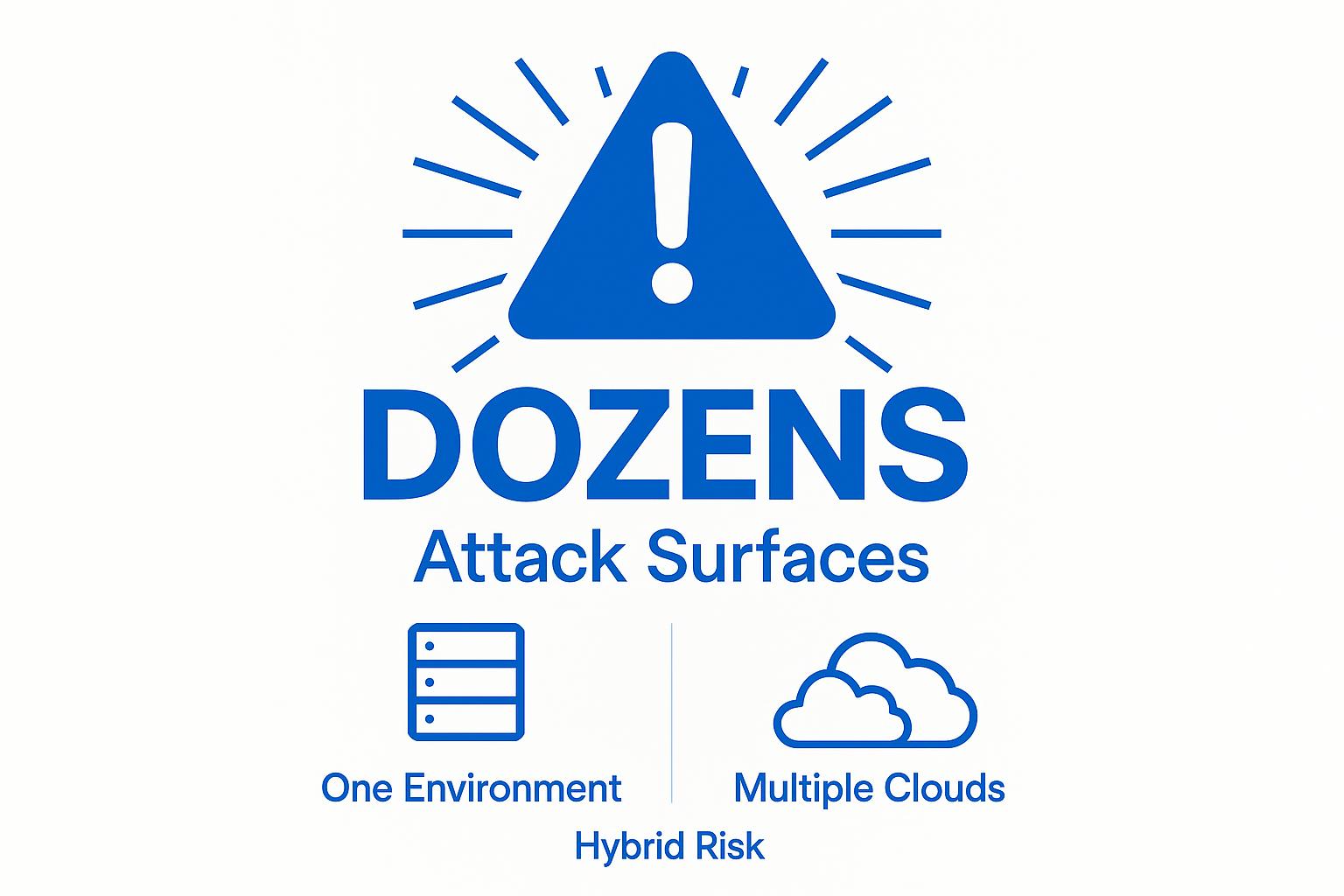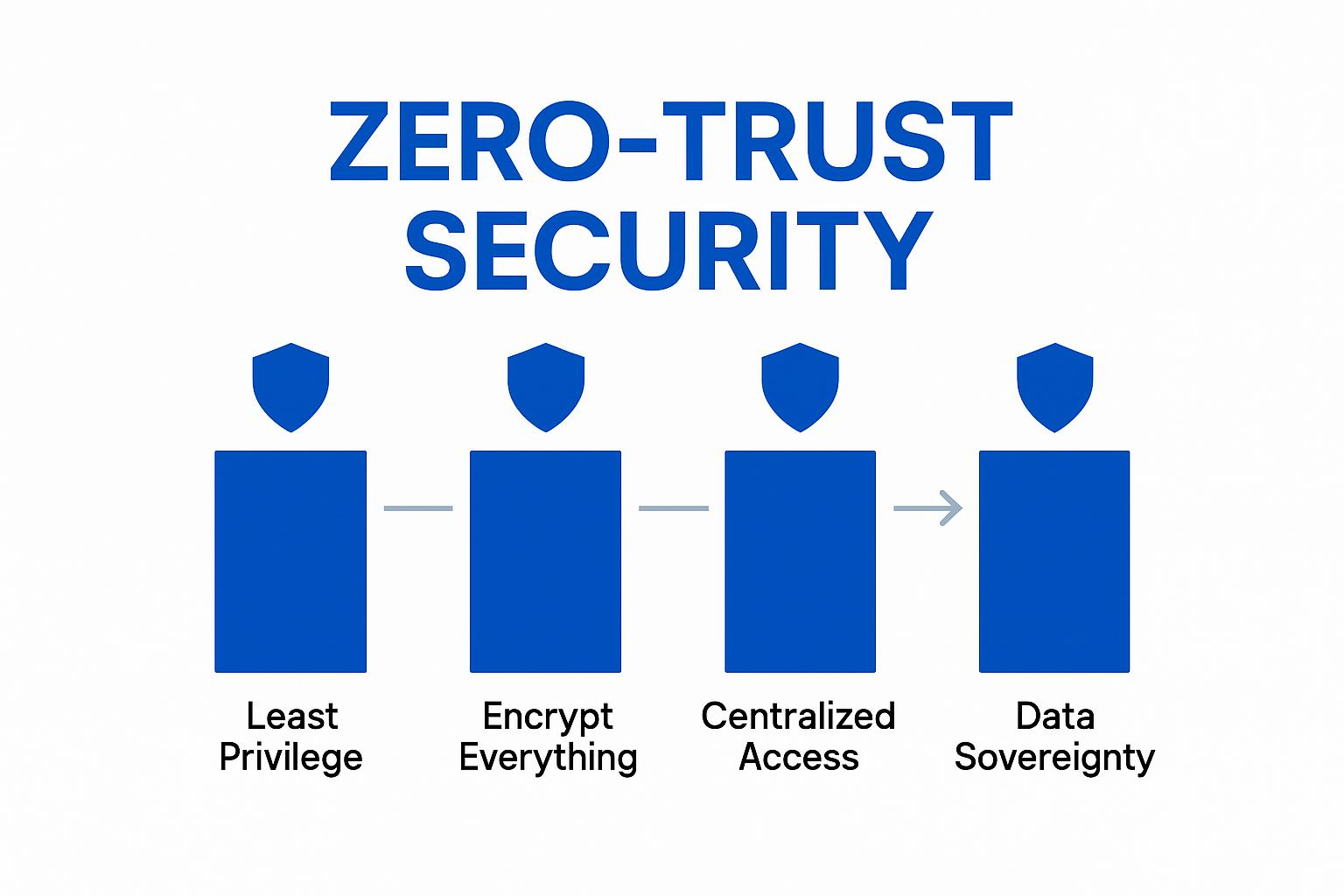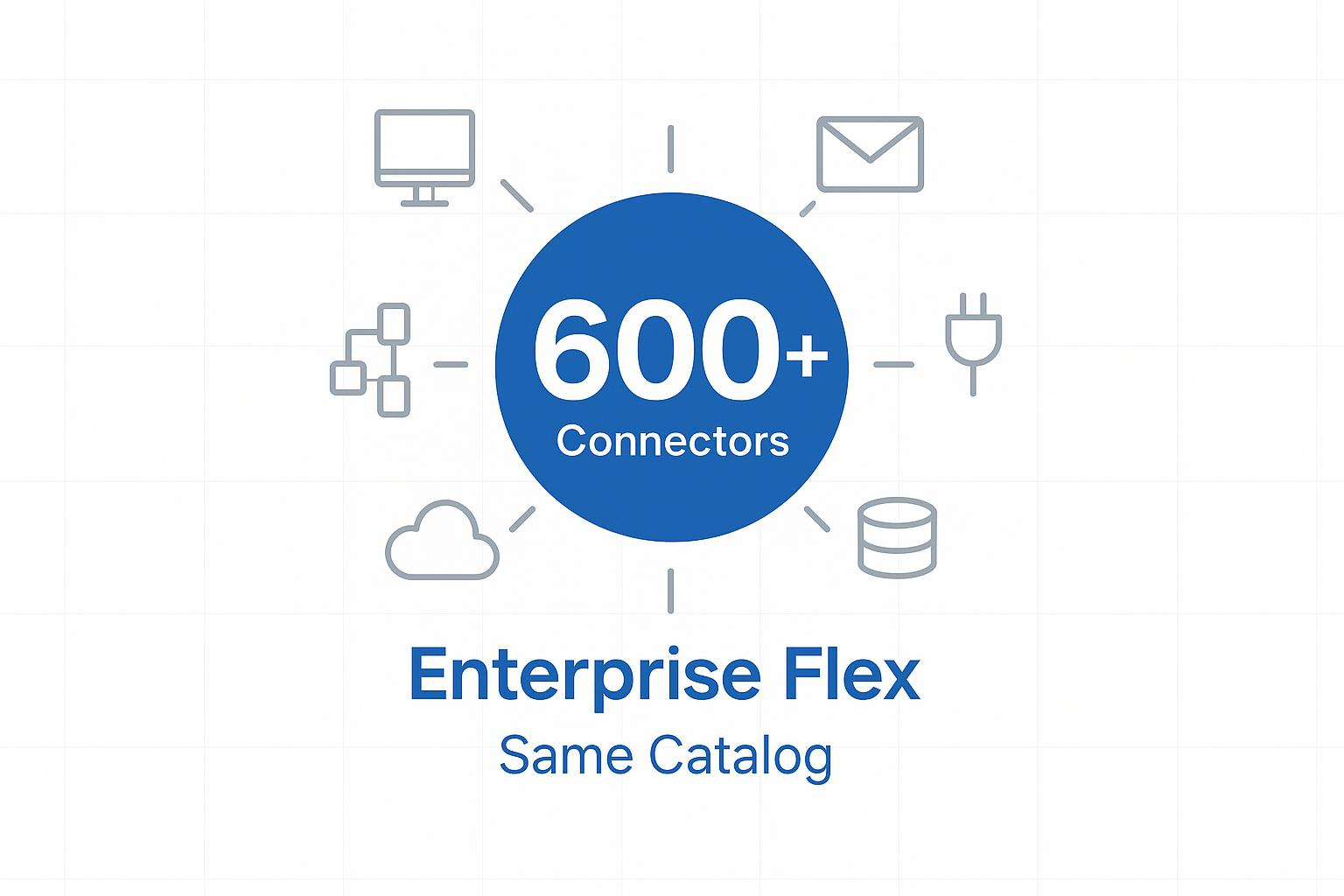Hybrid Cloud Data Security: Enterprise Architecture Guide
Summarize this article with:
✨ AI Generated Summary
A global bank's trading desk streams market data into an on-prem warehouse, then replicates to a public cloud lake for analytics. Overnight, a misconfigured cross-cloud job quietly copies EU client records to a U.S. region, violating GDPR and triggering an internal audit. What should have been routine ETL now exposes the bank to regulatory fines and reputational damage — all because no one had visibility into cross-environment data flows.
You face this same risk every time hybrid workflows span on-prem servers and multiple clouds. Adoption accelerates across finance, healthcare, and telecom, but fragmented infrastructure creates new threat surfaces and blind spots. Hybrid cloud security gaps and rapidly shifting configurations drive today's breaches. Compliance penalties, customer data exposure, and operational outages follow when security becomes an afterthought.
Starting with security-first architecture isn't optional. It's the only way to build hybrid ETL pipelines you can trust.
What Makes Data Security in Hybrid Cloud So Challenging?

Hybrid cloud environments create unique security challenges that traditional approaches weren't designed to handle:
- Attack Surface Explosion: Hybrid clouds scatter your workloads across on-prem servers and multiple public clouds, creating dozens of attack surfaces where once you had one. Each platform brings its own tooling, identity model, and logging format. Move data between them and you inherit every single vulnerability.
- Visibility Gaps: That sprawl kills visibility. Logs live in separate consoles, data flows hop through opaque managed services, and security teams lose track of where records actually go. These blind spots let attackers or careless developers exfiltrate sensitive data without triggering alerts.
- Configuration Drift: Misconfiguration makes everything worse. You spin up new instances, alter IAM roles, and extend networks daily in hybrid environments. One overpermissive bucket policy or forgotten firewall rule exposes protected datasets. Configuration errors drive most cloud breaches, with Darktrace research showing these issues accelerating across distributed environments.
- Legacy Defense Failures: Your on-prem network defenses don't work in the cloud. Ephemeral IPs, autoscaling groups, and managed services bypass traditional firewalls. You need to rethink segmentation and intrusion detection from scratch. Static security appliances were never designed for this.
- Regulatory Complexity: Regulatory complexity adds friction everywhere. GDPR demands strict safeguards for cross-border data transfers, HIPAA mandates audit trails, and ITAR restricts access to U.S. persons. Juggling these requirements across regions creates "compliance drift." Minor architectural changes quietly violate policy and invite fines, a pattern Commvault sees accelerating.
- Cascading Failures: The consequences hit hard. A financial firm's trading models broke when uncontrolled cross-border CDC replication pushed market data into an unapproved region, triggering latency spikes and regulatory alerts. In hybrid environments, one overlooked pipeline can wreck both performance and compliance. Recovery after the fact costs far more than designing for security upfront.
How Should Enterprises Think About Secure Hybrid Cloud Architecture?
Security works in distributed cloud environments only when you build it from the ground up. A security-by-design approach treats every layer as network, compute, data, and identity as untrusted until verified. This eliminates expensive security retrofits that break existing workflows.
Implement Zero-Trust Foundation
Start with least privilege across your control and data planes. Your orchestration layer gets minimal rights to schedule jobs. Your data processing layer gets only what it needs to connect and move data. When you combine this with zero-trust validation, every API call and connector launch requires authentication, regardless of where it originates.
Encrypt Everything Everywhere
Encrypt everything, everywhere. Data stays encrypted at rest in every region and re-encrypts at each network boundary. This blocks eavesdroppers and satisfies breach notification requirements in GDPR and HIPAA, which treat encryption as a compensating control.
Centralize Access Management
Access management can't stop at cloud boundaries. Consistent RBAC mapped to actual business roles prevents privilege creep and insider abuse. Centralized role catalogs let you audit permissions without hunting through multiple consoles.
Enforce Data Sovereignty
Respect data sovereignty requirements. Regulated datasets under frameworks like ITAR must never leave approved jurisdictions or be exposed to non-cleared personnel. This drives where you deploy data planes and how you store encryption keys. Tie these controls together with uniform policies so every environment follows on-premises, private cloud, or public region follows the same security rules.

What Are the Core Components of a Secure Hybrid Cloud Data Pipeline?
Securing a distributed data pipeline requires splitting responsibilities across distinct layers that each address different risk categories. When you separate control logic, data processing, identity, and governance, you can harden every layer without slowing down delivery.
Control Plane Security
The control plane handles job scheduling, configuration storage, and automation APIs. Since it rarely touches production data directly, it should sit behind outbound-only connectivity so nothing on the internet can reach it. Airbyte Flex's hybrid control plane demonstrates this approach: UI and orchestration run in the cloud while all communication with your environment happens over secured, outbound channels, removing the need for inbound firewall exceptions.
Lock it down with TLS-only endpoints, SSO or SAML authentication, and infrastructure-as-code templates. Configuration drift and setup errors remain a leading cause of breaches, but catching them during code review instead of production significantly reduces risk.
Data Plane Security
The data plane is where actual work happens: extractors connect to sources, transformers run, and loads push results to destinations. In a distributed model, keep this plane local—inside your VPC or on-premises network—so sensitive datasets never leave your boundary.
Airbyte Flex achieves this by running connectors next to the data and passing results through encrypted channels. Direct access to secret managers and source systems removes the need for public endpoints, limiting your exposed surface area and satisfying residency mandates.
Secrets & Identity Management
Hard-coding API keys creates pathways for lateral movement. Route every credential through an external vault like AWS Secrets Manager or HashiCorp Vault. Store references, not raw secrets, in pipeline configs. Follow these security practices to maintain credential hygiene.
Pair external vaults with federated identity so you control access from your central IAM. Granular RBAC—mapped to actual job functions, not generic "admin" roles—enforces least privilege and separation of duties.
Governance Layer
Even airtight pipelines need compliance proof. Immutable audit logs record every job run, config change, and credential use. These logs should funnel into your SIEM for real-time analytics.
Add column-level hashing or masking so analysts see only what they're cleared to view. Attach automated lineage tracking that ties each dataset to its upstream source. Automated policy checks catch encryption gaps or residency violations before regulators do, turning governance into a guardrail rather than an obstacle.
Which Security Patterns Work Best Across Industries?
You'll find the same baseline of zero-trust, encryption everywhere, and strict role-based access running through every secure multi-cloud environment. What changes is the emphasis each industry places on specific controls.
Across all four sectors, the pattern is the same: start with zero-trust, map data classification, then dial up residency, latency, or availability controls to meet your specific regulatory and operational obligations.
How Can Enterprises Implement Secure Hybrid Pipelines Step by Step?
Building a secure distributed pipeline isn't about finding the perfect tool. It's about following a disciplined sequence. When you tackle these tasks in order, you reduce rework and catch compliance gaps early, before data ends up in the wrong region or an unvetted cloud service.
1. Map Compliance Requirements
Start by cataloging every regulation that touches your data. GDPR demands consent, geographic controls, and 72-hour breach notification for EU personal data. HIPAA expects risk assessments, audit trails, and the implementation of encrypted PHI storage when reasonable and appropriate in U.S. healthcare contexts. ITAR goes further, prohibiting foreign access to defense technical data and requiring U.S.-managed encryption keys. Link each data domain to its governing rule set—this gives you a clear matrix for the controls you need to build.
2. Segment Workloads
With your compliance matrix in hand, decide what stays on-premises and what can leave. ITAR-controlled files must remain in U.S. infrastructure. GDPR personal data can only cross borders under strict safeguards. Less-sensitive telemetry or log data can run in a public cloud region close to your analytics team. This workload slicing reduces your attack surface while meeting residency mandates.
3. Deploy a Hybrid Control Plane
Spin up a cloud-hosted UI while keeping data planes inside your VPCs. In Airbyte Flex, the control plane issues jobs over an outbound channel. Your data plane pulls tasks without exposing inbound ports, preserving your firewall posture. This architecture also lets you place individual data planes in different regions to satisfy local sovereignty rules.
4. Enforce Security Controls
Layer on technical safeguards: end-to-end TLS, AES-256 encryption at rest, and keys stored in provider KMS or an on-prem HSM. Implement granular RBAC so roles align with job functions. Store connector secrets in an external vault rather than plaintext configs. Continuous posture monitoring catches misconfigurations. In distributed environments, they remain a top breach vector.
5. Validate With Test Scenarios
Test what you built. Run CDC replication under peak loads, measure end-to-end latency, and trigger simulated failovers to prove encrypted backups restore correctly. Automate compliance scans that flag drift against your original matrix, then document every outcome. Repeat these tests quarterly to keep your pipeline aligned with changing regulations and architecture updates.
What Outcomes Can Enterprises Expect from a Security-First Hybrid Cloud Architecture?
Build security into every layer of your distributed cloud infrastructure, and you get benefits that go far beyond audit checkboxes. You achieve real compliance without sacrificing performance or scale. End-to-end encryption, unified RBAC, and immutable audit logs significantly contribute to satisfying GDPR and HIPAA security requirements, but additional organizational and procedural controls are needed for full compliance while your architecture still scales on demand to hit those SLA-driven latency targets.
A hardened security posture cuts breach probability and the massive fines that follow misconfigurations. Continuous policy validation and zero-trust controls close the gaps attackers exploit, while real-world data shows this approach reduces incident rates significantly in multi-cloud environments.
Secure foundations accelerate your innovation roadmap. You can deploy analytics and AI workloads without data-sovereignty headaches, maintain predictable costs by avoiding bolt-on security tools, and recover faster when issues occur thanks to integrated, forensically sound logging. A security-first strategy transforms compliance overhead into competitive advantage.
How Does Airbyte Flex Replace Legacy ETL Security Challenges?

Traditional ETL platforms like Informatica and Talend weren't built for hybrid cloud security. They force you to choose between expensive on-premises deployments that can't scale or cloud-only architectures that violate sovereignty requirements. Airbyte Flex eliminates this impossible choice by replacing legacy ETL infrastructure entirely—for true hybrid deployment.
Instead of maintaining separate security stacks for different environments, Flex provides a unified security architecture. Orchestration runs in Airbyte Cloud while the data plane lives entirely inside infrastructure you control. Your sensitive records never leave your VPC, satisfying data-residency mandates while letting you decide exactly where processing happens—even in air-gapped environments.
You get the full catalog of 600+ open-source connectors without rewriting pipelines when requirements shift. Security features mirror what auditors expect in regulated industries: end-to-end TLS protects data in motion, metadata gets encrypted with AES-256 at rest, and granular RBAC with SSO integration provides least-privilege access control.
Column-level hashing and secret-vault integration keep credentials and PII out of repos. Immutable audit logs give you forensic traceability without the operational overhead of maintaining separate logging infrastructure for each environment.
Flex deployments inherit Airbyte Cloud's SOC 2 controls and align with GDPR and HIPAA requirements, so you can prove compliance without bolting on extra tooling. This replaces the patchwork of legacy ETL platforms, cloud security add-ons, and custom compliance scripts that create more vulnerabilities than they solve.
How Should Enterprises Move Forward?
You've seen that distributed cloud security only works when it's baked in from the first diagram, not bolted on later. Designing for sovereignty with control planes in the cloud, data planes in your VPC lets you meet residency mandates without sacrificing agility. Airbyte Flex delivers that pattern with 600+ connectors and enterprise-grade security controls. Talk to Sales about your multi-cloud security requirements.
Frequently Asked Questions
What's the difference between hybrid cloud security and multi-cloud security?
Hybrid cloud security protects data between on-premises and public clouds, ensuring consistent policies across environments. Multi-cloud security manages multiple public cloud providers only. Hybrid setups face complex compliance, needing both enterprise and cloud-native security adherence.
How do you handle data sovereignty in a hybrid architecture?
Ensure data sovereignty by mapping datasets to legal jurisdictions and processing them in approved regions. Use regional data planes, centralized control, automated policy enforcement, and cryptographic proof of location to comply with regulations and maintain auditability in hybrid environments.
Can zero-trust principles work in hybrid cloud data pipelines?
Yes, zero-trust is essential in hybrid pipelines. Treat all connections as untrusted, enforce identity-based access, require authentication and encryption for every transfer, and continuously verify users and devices to protect data across cloud and on-premises environments.
What compliance frameworks should I prioritize for hybrid cloud data security?
Prioritize compliance frameworks based on your industry and data types: GDPR for EU data, HIPAA for U.S. healthcare, CCPA for California residents, SOX/PCI DSS for finance, and ITAR/CMMC for defense. Design architecture to meet the strictest requirements first.
How do you measure the security effectiveness of a hybrid architecture?
Measure hybrid architecture security by tracking incident detection time, encrypted data flow percentage, audit pass rates, misconfiguration remediation time, data residency violations, failed cross-cloud authentications, and zero-trust adherence. Use regular penetration tests and compliance assessments for external validation.
What's the biggest mistake companies make when implementing hybrid cloud security?
The biggest mistake is treating hybrid security as an extension of on-premises models, over-relying on network perimeters, and underestimating identity management complexity. Successful implementations adopt zero-trust and identity-centric controls from the start, rather than retrofitting old policies.

.webp)
